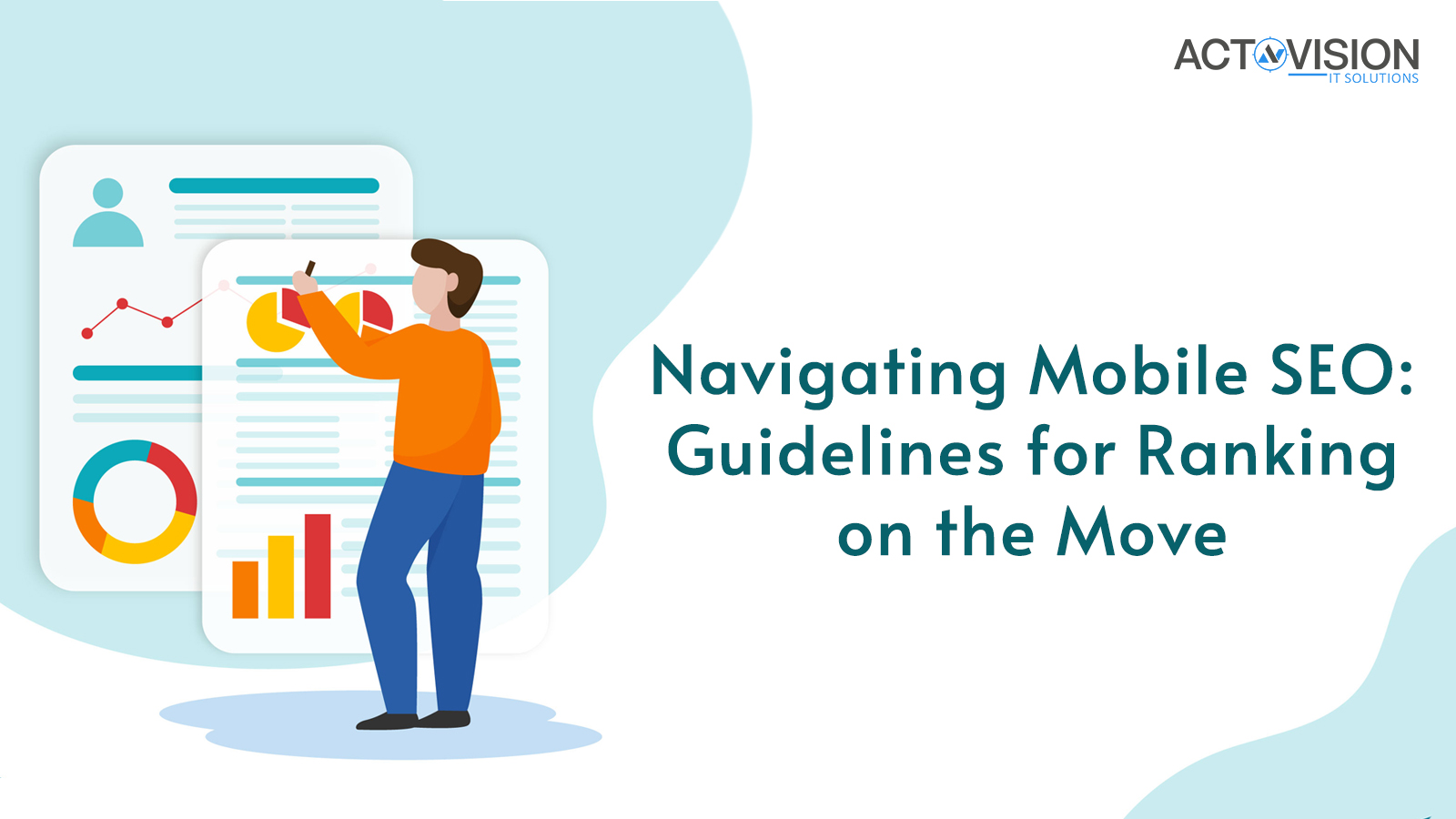As the internet evolves and more people access it from their mobile devices, having an effective mobile SEO strategy is now more important than ever. If your website isn’t optimized for mobile, you risk losing potential customers, customers’ trust, and ultimately, your search engine rankings. Mobile SEO is a complex and ever-evolving field, but with the right guidelines and strategies, it can be a powerful tool to help you reach your goals. In this blog post, we’ll go over some key mobile SEO best practices for ranking on the move in today’s mobile-first world.
Optimize for mobile users
Mobile SEO has become an integral part of any digital marketing strategy, especially with Google’s mobile-first indexing. It means that Google now predominantly uses the mobile version of a website’s content to rank pages.
When optimizing your website for mobile, always keep the user in mind. Users are more likely to convert when they have a positive experience on your site. Here are some ways to optimize your website for mobile users:
1. Responsive design
A responsive website adjusts to fit the screen size of any device. It provides a seamless user experience across different devices. Responsive design can increase mobile traffic and reduce bounce rates.
2. Use legible fonts and appropriate font size
Make sure the text on your website is readable on small screens. Use legible fonts and appropriate font sizes. Avoid using fancy fonts or small fonts that can make it hard for users to read the text.
3. Simple navigation
Navigation is critical for a user-friendly experience. Ensure your site navigation is simple and intuitive, so users can easily find what they are looking for.
4. Clear call-to-action
Clear calls-to-action can encourage users to take action, such as filling out a form or making a purchase. Make sure your calls-to-action are visible, simple, and easy to click on.
By optimizing for mobile users, you will not only improve the user experience but also increase the chances of ranking higher in search engines. Always keep the user in mind and provide a seamless experience that encourages conversions.
Optimize your website for mobile devices
With the majority of online traffic coming from mobile devices, it’s crucial that your website is optimized for mobile users. Not only does this improve user experience, but it also helps with your mobile search rankings.
Firstly, make sure your website is mobile-friendly by using a responsive design. This means your website will automatically adjust to fit any screen size, whether it’s a desktop or mobile device. This will ensure that your website looks great and functions properly on any device.
Next, consider the placement of your content. Mobile users have less screen space to work with, so you need to make sure your most important content is easily accessible. This includes your call-to-action buttons, contact information, and key messaging.
Another important factor to consider is page load speed. Mobile users are often on-the-go and expect quick load times. If your website takes too long to load, users will quickly leave and find another site. Use tools like Google PageSpeed Insights to analyze your website’s speed and identify any areas that need improvement.
Lastly, optimize your images for mobile devices. Large, high-resolution images can slow down your website’s load time. Instead, use compressed images that are optimized for mobile devices. This will improve your website’s speed and overall user experience.
By optimizing your website for mobile devices, you can ensure that your website is accessible and functional for mobile users. This will not only improve your search rankings but also provide a better user experience for your audience.
Use responsive design
In today’s mobile-first world, having a responsive design is essential for mobile SEO success. Responsive design means that your website’s layout and content adjust and adapt to different screen sizes, making it easy for users to navigate and engage with your website on any device.
Using a responsive design has many benefits, including improving user experience and reducing bounce rates. It also ensures that your website looks and functions properly on all mobile devices, whether it’s a smartphone or a tablet.
To ensure your website has a responsive design, you may want to consider hiring a web developer or using a website builder that offers responsive design templates. With a responsive design, you can create a seamless mobile experience for your users, which can ultimately lead to higher engagement and conversions.
When optimizing your website for mobile devices, it’s also important to keep in mind that mobile users are typically looking for quick access to information. Therefore, consider simplifying your website’s design and reducing the amount of content on your mobile pages. This can help to make your website load faster and improve user experience on mobile devices.
By incorporating responsive design into your mobile SEO strategy, you can ensure that your website is optimized for all mobile users and improve your chances of ranking well in mobile search results.
Improve your page load speed
In the fast-paced world of mobile browsing, every second counts. It’s no secret that slow-loading pages can frustrate users and send them clicking away to a competitor’s site. Therefore, it’s essential to prioritize your page load speed when optimizing for mobile SEO.
There are many ways to improve your page load speed, but the first step is to determine how your website currently fares. Google’s PageSpeed Insights tool is a great place to start. It analyzes your site’s speed and performance and offers suggestions for improvements.
One common issue that slows down mobile page speed is large image files. High-resolution images can take longer to load on mobile devices, so it’s essential to compress them. Using an image optimization tool can help reduce file sizes while maintaining quality.
Another effective technique to improve page load speed is to enable browser caching. This allows returning users to load pages faster since their browser will remember previously loaded data and only download updated content. This results in a significant reduction in page load time.
Lastly, minimizing HTTP requests by reducing the number of elements on a page is also a useful technique. Combining multiple CSS and JavaScript files into one, reducing the number of redirects, and optimizing code are some ways to accomplish this.
Improving your page load speed can have a significant impact on your mobile SEO rankings and user experience. Prioritize this optimization technique to stay ahead of the competition and provide an excellent user experience for mobile users.
Optimize your images
Images can greatly enhance the user experience on your website, but they can also slow down load times if not optimized correctly. This is particularly important in a mobile-first world, where users are looking for fast, easy-to-use websites on their mobile devices. Here are some best practices for optimizing your images for mobile SEO:
1. Compress your images: Large image files can slow down your website’s load time. Use an image compressor to reduce the size of your images without sacrificing quality. There are many online tools available that can help you do this.
2. Use the right file type: JPEGs are best for images with a lot of color and detail, while PNGs are better for graphics and logos. Use the appropriate file type for each image to ensure they load quickly and look their best.
3. Optimize your alt tags: Alt tags are an important part of SEO, especially for mobile devices. They provide text descriptions of your images for visually impaired users and search engines. Make sure to include descriptive, keyword-rich alt tags for all your images.
4. Implement lazy loading: Lazy loading is a technique that loads images only when they’re needed, instead of all at once. This can significantly improve your website’s load time and overall performance.
5. Avoid using large background images: Large background images can look great on desktop screens, but they can be overwhelming on smaller mobile devices. Try to limit your use of background images or use a smaller, optimized version for mobile users.
By optimizing your images for mobile devices, you can improve your website’s load time and overall user experience. This can lead to better mobile rankings and increased traffic to your site.
Implement Schema markup
Schema markup is a code that helps search engines understand the content on your website. By using Schema markup, you can provide search engines with additional information about your website, which can improve your website’s ranking on mobile search results.
For mobile SEO, Schema markup can be especially beneficial as it helps Google display rich snippets in search results, which can attract more clicks and improve your website’s visibility.
To implement Schema markup on your website, you’ll need to add code to your website’s HTML. There are several types of Schema markup you can use, including local business, product, and article schema. When adding Schema markup, be sure to use the correct schema type for the content on your website.
Once you’ve added Schema markup to your website, be sure to test it using Google’s Structured Data Testing Tool. This will ensure that your markup is correct and that Google can understand the content on your website.
By implementing Schema markup on your website, you can help search engines better understand your content, improve your website’s ranking on mobile search results, and increase the likelihood of users clicking on your website in search results.
Monitor your mobile rankings
After you’ve implemented the above mobile SEO best practices, it’s crucial to track and monitor your mobile rankings. By doing so, you can gain insights into how well your site is performing on mobile devices, and identify areas where you may need to make improvements.
To track your mobile rankings, you can use tools like Google Search Console or SEMrush. Both tools will give you visibility into how your site is performing in search engine results pages (SERPs), and show you which keywords are driving traffic to your site.
Once you have this information, you can use it to optimize your mobile strategy further. For example, if you notice that a specific keyword is driving a significant amount of traffic to your site, you could create more content around that topic, or optimize your existing content to target that keyword.
Additionally, monitoring your mobile rankings can help you stay on top of any changes in mobile search algorithms or user behavior. For example, if Google announces a significant algorithm update that impacts mobile rankings, you’ll want to be aware of this and adjust your strategy accordingly.
Conclusion
From conducting thorough keyword research to crafting compelling content, optimizing your website’s architecture, and building high-quality backlinks, we leave no stone unturned in ensuring that your website is optimized to perform at its peak potential.
Our holistic approach to SEO involves analyzing your website’s current state and identifying areas for improvement, followed by implementing best practices and monitoring performance regularly. With our data-driven insights, we are able to continually fine-tune our strategies to stay ahead of the competition and ensure maximum ROI for our clients.
At Actovision, we don’t just provide SEO services; we build long-term partnerships with our clients, ensuring that their success is our top priority. Trust us to take your online presence to the next level and beyond. Contact us today to get started.






